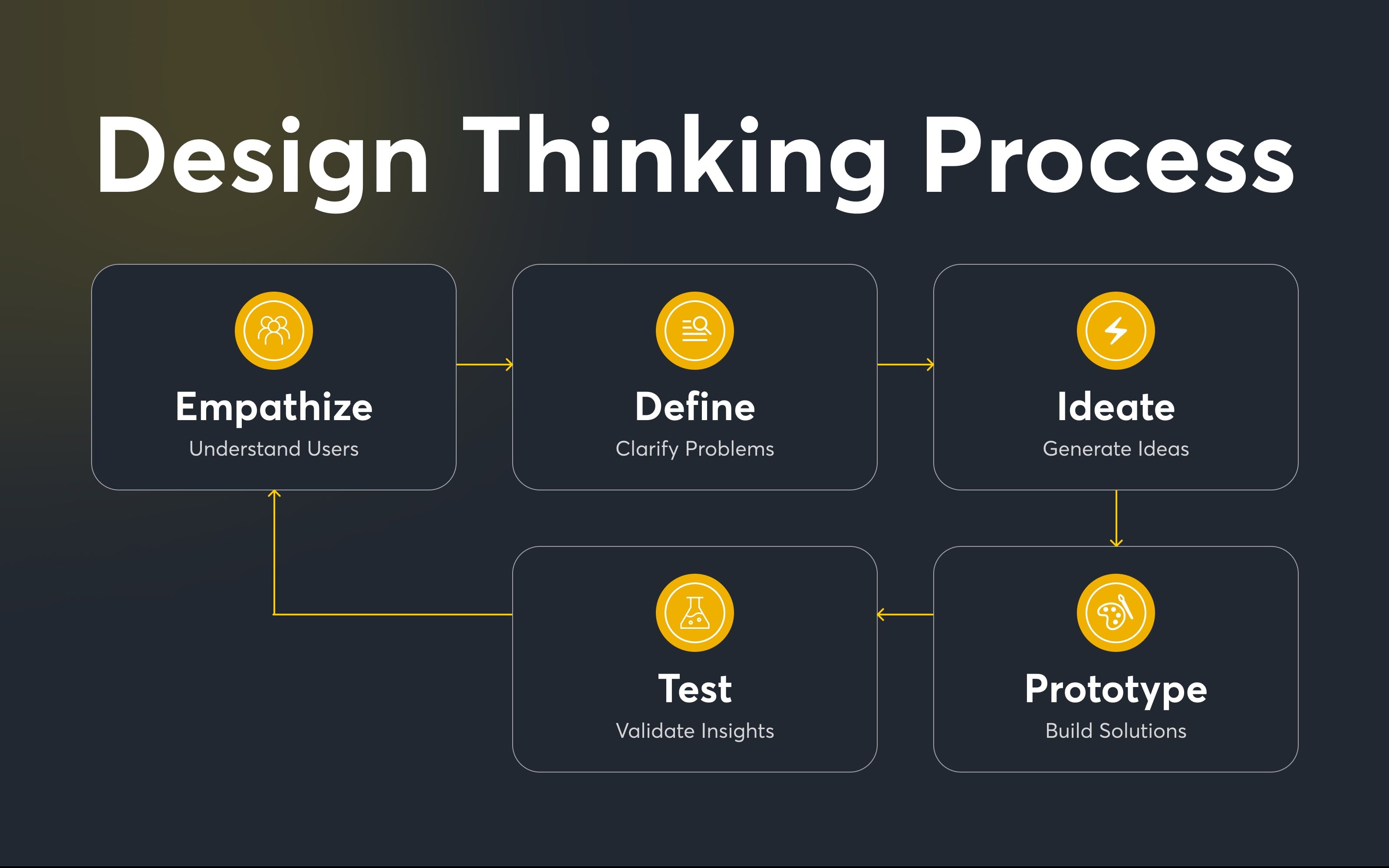Ever wondered about the reason behind enterprise software that is intuitive, easy to use, and grabs users’ attention while others lack user-friendliness and fail to engage? The quick answer is: Not applying the design thinking approach. Enterprise applications that are designed by adopting a design thinking approach not only make the software functional but also enjoyable, as it prioritizes user needs and expectations.
Curious to learn more about what a Design Thinking Approach is and what its benefits are in enterprise software development? Continue reading this article to discover more about the role of design thinking in enterprise software development. Additionally, you’ll learn practical tips for implementing design thinking in enterprise applications and overcoming the challenges involved.
What is Design Thinking in Enterprise Software Development?
 Designed by Freepik
Designed by Freepik
When talking about design thinking, people often mistake this term for “making the design look perfect, attractive, and visually appealing,” while reality is far more than just aesthetics. Design thinking is about creating solutions that are deeply aligned with users’ needs, focusing on usability, functionality, and solving real problems.
It’s a user-centered approach to solving real-world challenges by prioritizing the end-user experience. It involves understanding user needs, defining specific problems, and iterating on solutions to ensure the software delivers meaningful, impactful experiences beyond just a polished look.
For example, when building a customer experience (CX) platform, you can apply design thinking by focusing on the challenges customers face throughout their journey, such as long response times, inconsistent service, or difficulty finding support. Start by empathizing with customers through feedback and journey mapping to understand these pain points and apply design thinking to overcome them.
Likewise, when you plan to develop an enterprise-grade CRM, understand the workflows, pain points, and goals of the end-users—such as sales teams, customer support, and management. Through interviews, observations, and data analysis, you can identify key challenges like difficulty tracking customer interactions, managing leads, or generating reports. With these insights, your team can ideate and prototype potential solutions. It helps you create a CRM that is intuitive and functional, ultimately improving productivity and user satisfaction across your organization.
Five Key Stages of Design Thinking in Enterprise App Development

The following are the five key stages of design thinking, which are discussed below:
1. Empathize
The initial stage begins when you empathize with users by understanding their needs, emotions, and challenges. Through interviews, surveys, and observations, you gain insights into their daily interactions to uncover hidden pain points. Empathy helps you build a deep connection with users, enabling you to provoke their emotions and expectations into developing user-focused enterprise software.
2. Define
After gathering insights, the next stage is to define the core problem that you’re trying to solve. Defining the problem accurately will ensure that each subsequent step directly addresses user needs and expectations. This statement provides a guiding focus for the rest of the design process.
3. Ideate
In the ideate phase, you brainstorm ideas to come up with a range of potential solutions to the defined problems. This collaborative stage encourages diverse ideas, allowing you to challenge assumptions and think outside the box. With team input from various perspectives, you generate multiple solutions that directly tackle the defined problem and align with user-centered goals.
4. Prototype
The prototyping phase is where you transform your creative ideas into tangible, testable models, such as sketches, wireframes, or clickable demos. These prototypes serve as an early version of your solution, allowing users to interact with the core features. The goal is not perfection but functionality, as prototypes are a low-cost way to validate ideas and uncover usability issues.
5. Test
Testing is where you gather feedback by observing how users interact with your prototype, gaining insights into what works and what doesn’t. This phase is highly iterative—based on the feedback, you may need to revisit and refine previous stages to better align with user needs. Testing not only validates your solution but also provides a final opportunity to make necessary adjustments.
Benefits of Design Thinking in Enterprise Software Development
 Designed by Freepik
Designed by Freepik
The following are the benefits of adopting the design thinking approach to enterprise software development:
- User-Centric Solutions: It aligns deeply with user needs, leading to increased satisfaction, engagement, and adoption rates. By emphasizing empathy and direct user insights, you create solutions that resonate and deliver true value to the end users.
- Faster Time-to-Market: Design thinking also accelerates the development and launch process by using iterative design and testing methods. This agile approach helps you identify and address issues early, saving time in development and accelerating the time-to-market.
- Innovation and Creativity: By encouraging out-of-the-box thinking, design thinking allows teams to explore innovative solutions beyond traditional approaches. Tools like Asana and Trello boost team productivity by organizing tasks, enhancing collaboration, and simplifying project tracking, making work easier and more transparent.
- Enhanced Automation and Efficiency: By identifying repetitive tasks and streamlining workflows, design thinking enables automation that reduces manual effort and boosts overall efficiency, allowing teams to focus on more strategic, value-added activities.
- Reduced Risk: Testing ideas early in the design process reduces the risk of costly errors and app failures. With continuous feedback and iteration, you refine the product, ensuring it meets user needs before full-scale development.
- Cross-Functional Collaboration: Design thinking promotes collaboration across IT, design, and business teams, aligning diverse perspectives and expertise. This approach improves communication, enhances teamwork, and leads to more cohesive and effective project outcomes.
- Improved ROI: User-centered, innovative solutions directly translate to higher user engagement and success. By focusing on real needs and effective problem-solving, design thinking ultimately boosts return on investment and app longevity in the market.
How to Implement Design Thinking into the Enterprise Software Development Process
 Designed by Freepik
Designed by Freepik
When building your enterprise software, you can apply the design thinking technique in the following manner:
Defining the Problem and Setting Goals
The first step towards developing enterprise software using a design thinking approach is to clearly define the core problem your enterprise software aims to solve. Begin by identifying:
- What specific user pain points or challenges are we addressing with this software?
- How does this problem impact the user experience or the business outcomes?
- Who are the primary users, and what are their main objectives when using this software?
- What measurable outcomes will indicate the success of our solution?
- What constraints (e.g., time, budget, technology) do we need to consider in our solution?
- How will this software align with our overall business strategy?
These questions will help you define the core problem and set clear goals that meet real customer needs, stand out in the market, and drive long-term success. By analyzing these questions, you can gain deeper insights into your customer needs, refine your solution, and deliver user-focused software that is both functional and easy to use.
Creating User Personas
To get insight into your target audience’s goals, behaviors, and pain points, you need to create user personas. It helps to design solutions that align with their real needs and preferences. For example, if you want to develop a customer experience (CX) enterprise software, you need to create user personas to identify who your primary users are, their specific needs, goals, and the challenges they face throughout the customer journey.
Here are the steps to create an effective user persona for customer experience (CX) enterprise software:
- Conduct User Research: Gather information through interviews, surveys, and feedback sessions with customers and end-users to understand their experiences and expectations.
- Segment Users by Roles and Needs: Identify different user roles (e.g., customer support agents, managers) and categorize them based on shared goals, pain points, and specific requirements within the CX journey.
- Define Demographics and Background: Outline key demographic details, such as job title, department, and industry, to better understand their role and context within the CX software.
- Identify Goals, Needs, and Pain Points: Specify what each persona aims to accomplish, their daily challenges, and any particular needs related to improving customer experience.
- Add Real-Life Scenarios and Quotes: Create realistic scenarios and sample quotes that represent each persona's interactions with the software to make them relatable and actionable for the development team.
- Validate and Refine Personas: Share personas with stakeholders, gather feedback, and update them to ensure they accurately reflect user needs and can guide the design and development process.
Ideation and Brainstorming
Once you’ve identified the problems, conducted user research, and created a user persona, the next stage is the ideation phase. Here, gather your team for brainstorming sessions that encourage creative, unrestricted thinking. In this collaborative environment, you’ll explore various ideas, combining insights from different team members to solve the challenges you uncovered. When brainstorming ideas about building a customer experience platform (UX) for your enterprise, you need to identify:
- How will the platform support personalization to enhance customer interactions?
- What tools and features will empower users to resolve customer issues efficiently?
- How can the platform facilitate seamless data integration from various customer touchpoints?
- What insights should the platform provide to help teams anticipate and improve customer needs?
- What specific features you can add that would improve their experience and productivity?
- How can the platform measure and report on customer satisfaction and engagement metrics?
- What security and privacy measures are necessary to protect customer data?
- How will the platform support multi-channel interactions (e.g., chat, email, social media)?
Here, you can also identify potential features and functionalities that could address user needs and improve their experience. When building your customer experience enterprise platform, you can include the following key features:
- Real-time Feedback Collection Tools: It helps instantly capture user feedback to enhance decision-making and optimize customer experiences.
- Personalization Engine: You can deliver tailored experiences by customizing content and recommendations for each user.
- Analytics Dashboard: Implementing a dashboard lets you track and analyze key metrics to gain actionable insights and improve platform performance.
- Multi-Channel Support Integration: To seamlessly manage customer interactions across email, chat, phone, and social media in one place, implement multi-channel support.
- AI-powered Analytics Tools: Leverage artificial intelligence to uncover trends, predict behaviors, and make data-driven decisions.
- Knowledge Base Management Tools: To help users access self-help resources like FAQs and guides for quick problem-solving, consider knowledge-base management tools.
- Collaboration Tools: Implement collaboration tools to facilitate seamless teamwork and communication and improve efficiency and project outcomes.
Prototyping
Now, you can proceed toward transforming your creative ideas into prototypes- clickable models that allow users to interact with core features. With prototypes, you map out everything from information architecture to the user journey, test navigation flow, and gather valuable feedback from end users. You can outline the platform’s structure, define key elements such as dashboards or feedback tools, and ensure seamless workflows through effective prototyping.
This step bridges ideas with functionality, ensuring the platform meets user expectations effectively. For designing the prototype, you can use digital tools like Figma to frequently create prototypes. You can refine designs and identify usability issues early in the process through prototyping.
Performing Usability Testing
Once you’ve built the tangible prototype, it’s time to perform usability testing of your CX enterprise software. Usability testing is essential for validating the customer experience (CX) platform’s design and functionality. By observing real users interact with the platform, you can identify pain points, understand user behaviors, and gather insights on navigational flow.
Testing various elements, from feedback collection tools to data dashboards, helps ensure the platform is intuitive and meets user needs effectively. Platform like UserTesting allows you to gather real-time feedback on usability. Using this tool, you can test prototypes or live products, offering insights that drive iterative improvements for a more seamless experience.
Iterating and Refining
Iteration and refinement are key steps in optimizing the CX platform based on usability testing feedback. With each cycle, adjust features, improve workflows, and resolve usability issues highlighted by real user interactions.
This continuous improvement process helps align the platform with end-user expectations, making it more efficient, responsive, and valuable over time. Through consistent iteration, you create a platform that not only serves current needs but adapts to evolving customer experience requirements.
Challenges of Design Thinking in Enterprise Software Development
 Designed by Freepik
Designed by Freepik
Design thinking is a game-changer in enterprise app development, as it features many benefits, but with this, certain challenges come along with the adoption of design thinking in enterprise software development. Listed below are the key challenges of adopting design thinking in enterprise software development:
Cultural Resistance
- What’s the Challenge? Implementing design thinking often encounters resistance as teams may be set in traditional ways of working, making it challenging to adopt new, user-centric methodologies.
- Solution: Promote a user-centered mindset through workshops and training sessions to gradually shift team perspectives and integrate design thinking principles.
Difficulty in Sustaining User-Centric Focus
- What’s the Challenge? Enterprises may struggle to maintain a user-centered approach throughout development as competing priorities and business needs can shift focus away from the end user.
- Solution: Establish dedicated roles or checkpoints that ensure user needs remain a priority throughout the development process.
Limited Collaboration Across Teams
- What’s the Challenge? Effective design thinking demands cross-functional collaboration, which can be challenging in siloed environments where departments have different objectives and communication barriers.
- Solution: Foster cross-functional teamwork by creating shared goals, regular communication channels, and collaborative workshops that encourage alignment.
Managing Iterative Changes
- What’s the Challenge? The iterative nature of design thinking requires continuous feedback and adjustments, which can be difficult to coordinate and manage within complex enterprise projects.
- Solution: Implement agile project management tools to track iterations, feedback, and changes smoothly, ensuring all teams stay updated.
Scaling Design Thinking Practices
- What’s the Challenge? Scaling design thinking across large enterprises is challenging, as it requires consistent training, support, and alignment with company-wide strategies to ensure effective adoption.
- Solution: Develop a standardized framework and ongoing training to scale design thinking practices consistently across the organization.
Key Takeaways
The article covered different key sections, explaining what design thinking is, what are its benefits, and its key stages. In short, design thinking is the approach to building customer-focused enterprise software solutions that effectively address user's pain points and challenges. Overall:
- Design thinking revolves around the five main key stages, including emphasizing with users, defining the specific problem, brainstorming creative ideas, building prototypes, and refining them based on user feedback.
- The benefits include elevated user experience, faster time-to-market, improved creativity, enhanced efficiency, and much more.
- The challenges involved in adopting design thinking and how to overcome them.
For efficient and user-centric enterprise software solutions, consider partnering with Cygnis– a leading software development company with around 300+ successful projects completed. Let’s collaborate to build custom enterprise software that drives growth and exceptional user experiences. Contact us today!

